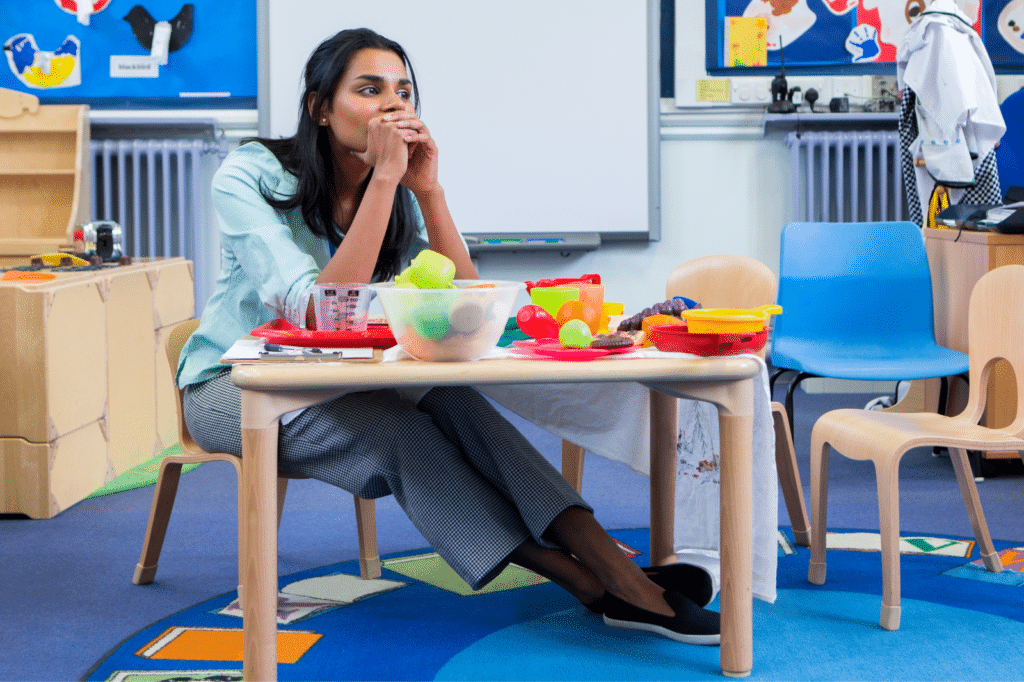The mounting stressors in teaching—changes in funding, pressures in state testing, disengaged parents, school violence—were already contributing to increased burnout for many teachers. Now, as teachers living and working in a pandemic, you are coping with the complex and collective trauma not only of yourself but of your students, colleagues, and administrators. Seeing and hearing about others’ traumas and how those traumas affect them, takes an emotional and physical toll. We call this Vicarious Traumatization.
Throughout this blog series (Teaching in Traumatizing Times), we’ve offered a variety of tools situated in an attachment framework with the aim of supporting you in your work. But there is another set of relationships that are key to teaching in pandemic times: your relationships with yourself and your work. We aren’t here to tell you about the importance of self-care outside the classroom, setting boundaries, and leaving work at work. We’ve all been hearing those things since long before COVID-19 came on the scene. Rather, we hope to offer some additional tools and perspectives. Things you can use both at work and in your personal life to manage the impact of exposure to the traumas of others during pandemic times and beyond.
What is vicarious trauma?
Vicarious trauma is a process where our own worldview is changed by exposure to others’ traumas. It affects teachers’ brains similarly to how trauma impacts students’ brains: we have a fear response that triggers changes in our body, mind, and emotions. And, as with the initial trauma, if this response is not able to be worked through, then it often gets “stuck,” leading to a host of symptoms.
These symptoms run the gamut: physical distress (headaches, fatigue, insomnia, and stomach distress); emotional distress (irritability, anxiety, guilt, numbness, and depressed mood); cognitive changes (trouble concentrating, confusion, feeling detached, and intrusive thoughts); and changes in behaviors (overeating, socially isolating, avoiding certain students, missing meetings or deadlines, and being habitually late). Currently, with the collective traumas our society is facing, we are seeing increased risk of vicarious trauma amongst teachers. This can compound our struggles and make compassion—for ourselves as much as for others—that much more difficult to maintain.
So, what can we do about it?
That last piece—difficulty with compassion—is really important here. Simply acknowledging that we and our students are dealing with trauma is the first step towards coping. We’ve already talked about ways to proactively incorporate supports into our routines, classroom environment, and interactions with students and parents. It’s important that we do the same for ourselves. We know that to treat trauma we need to cope with triggers and reduce emotional overwhelm. Similarly, when we are preventing and treating vicarious trauma, we need use those same tools as we work, not just rely on self-care outside our work.
Those tools fall into five main categories: experiential engagement, regulating rumination, intentional narrative, reducing emotional labor, and parasympathetic recovery.1
Experiential Engagement
Experiential engagement is all about staying present and allowing ourselves to feel the feelings that come up when difficult things happen or are shared by others. Often in the middle of hard things we shut down our own feelings, thinking “I don’t have time for this.” It’s commonly believed that caring “more than we should” will get us into trouble, so we numb, avoid, and distract. But running from our feelings, only seems to make them bigger in the long run. We can stay engaged with our feelings in a few key ways:
- Accept that painful feelings occur when we are so involved in others’ lives and that you will choose to feel them.
- Noticing the feelings—and this may start with noticing when we aren’t having any during difficult situations. Ask yourself “what am I feeling?” and “how do I know?”
- It can feel hard to trust that the feelings will fade, but that’s how it works on a basic physical level: like waves in the ocean, they come on strong and then recede. Also like waves, if we don’t allow ourselves to ride them, it’s easier to get swept away. The final step is to let the feeling be there and let it pass without getting caught up in replaying the event or the feelings it creates.
Regulating Rumination
We are hard-wired to replay events in our mind over and over. This can help us stay connected to those who aren’t there, imagine new ways of doing things, and problem-solve. But ruminating on an event (i.e., replaying it over and over in our mind) brings back all those feelings and all the physical, mental, and emotional changes that go with them. And unfortunately, once those strong feelings return, they often trigger more rumination. We get stuck in an endless loop that makes it harder to solve problems. We can deal with this in a few key ways:
- Noticing and naming when we are ruminating.
- Redirect our thoughts to something else, especially if it’s goal-oriented. It can help to have already decided what activities are most useful for this.
- Get connected to others, not only by sharing what we are experiencing, but also just being social. They key is to interrupt that loop and get our minds (and thus feelings!) on something else.
- Shift how we think. Rumination tends to be focused on going through events, making judgements, or thinking about feelings. Instead, focusing on concrete, specific, action-focused topics and tasks can break the mental cycle.
Intentional Narrative
Humans are story-making creatures. And for good reason—telling stories helps us make meaning of events in ways that provide coherence and calm where there was chaos. Making a story of difficult events also helps us experience that event again in a way that lets us process through any lingering feelings or fragmented thoughts. We can create helpful stories of our exposure to others’ traumas in a few key ways:
- Before we head into the classroom or meeting, name for ourselves the purpose of what we are doing. Why are you there? What is your role?
- “I am a skilled educator. As part of that work, I see and hear some really difficult things in the lives of those I teach and work with. I have the skills to fulfill my role and its demands in meaningful ways.”
- When things get difficult in the classroom, use your story to support you in coping in the moment. The key here is to remind yourself that you have the skills to handle difficult situations in your work, that these are part of that work, rather than something to be avoided.
- Make meaning of the hard times. When you are exposed to these traumas, make space to reflect on how you were affected physically and emotionally, how you behaved, and what that means to you. This is not ruminating, where the focus is replaying the trauma itself or your feelings about it repeatedly.
- “Today James shared something that was really hard to hear. I felt myself want to get up and walk away. It was hard to hear, and I wanted to cry. I was able to listen to him and validate his feelings so he didn’t feel alone. I let myself feel the sadness and did the best I could for him. I wish I could fix it, but I know I can’t. What I did was important, and I did good work today.”
Reducing Emotional Labor
We often find ourselves in the position of having a lot of feelings and not being able to express them. Whether because of environmental factors (“I can’t breakdown at work, what would people think”) or psychological factors (“I just don’t have it in me”), we find ourselves pushing those feelings away. But as we pointed out earlier, this often makes things worse. So how can we manage these expectations and appropriately acknowledge our genuine feelings? We can do this in a few key ways:
- Build up our empathy. Empathy is a skill that helps reduce the need to pretend to experience only certain emotions. Get curious about what feelings are underneath our own and others’ behaviors. What are the feelings we have a hard time coping with? Notice patterns in when and how we pretend our emotions are different.
- Routinely identify and express our feelings in healthy ways. Practice skills that support everyone in the classroom, for example by using a social-emotional learning curricula.
Parasympathetic Recovery
Parasympa-what? Parasympathetic recovery is just a fancy way of saying that in the moment when difficult things are happening, you engage in strategies that regulate your body and mind. This requires becoming aware of your own internal state and having identified strategies in place that you can use in the moment at work. That’s not to say self-care outside work isn’t important, but we can take care of ourselves throughout our day, as well. We can support our regulation in a few key ways:
- Structure your day to include a few moments to practice self-regulation strategies either alone or with your students: a few deep breaths, a routine way you welcome students, or a gentle stretching routine.
- Develop a few brief mindfulness and self-compassion strategies that you can use in the moment while working, even habitually doing them during transitions in your schedule. Bonus points for getting comfortable modeling this behavior to your students by naming what you are doing and why!
- This one is especially important for mentors and administrators: create a culture where whenever you engage with staff, you are supporting these skills. This means making time to check in with teachers to support them in making a meaningful narrative of it, stepping in if possible to give staff a break to regulate, and using regulation strategies in meetings to support self-care.
As teachers, being exposed to the difficult life events of others is just a fact of life. But It’s also something that has a very real and concrete effect on your body, mind, and emotions, and carries potentially long-term impacts in your own life. Teaching in pandemic times has compounded this issue by increasing the trauma everyone is experiencing–traumas that may impact you, your students, and your colleagues for years to come.
Our aim with this blog series has been to provide a framework for understanding and managing some of the behaviors that may be happening in your classroom as a result of global circumstances completely outside our control. The most effective ways to cope are embedded in your relationships—with others and with yourself.
Thank you for all you do as educators. As therapists working with children, we get to see the good work you are doing and the important role you play every day. We value you and your work, and your impact in our children’s lives and our communities.
1 Miller, B., & Sprang, G. (2017). A components-based practice and supervision model for reducing compassion fatigue by affecting clinician experience. Traumatology, 23(2), 153–164. https://doi.org/10.1037/trm0000058










